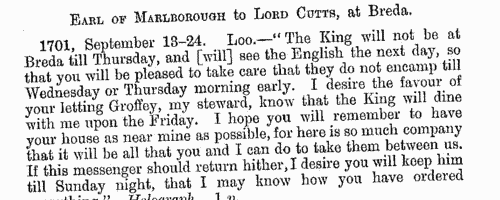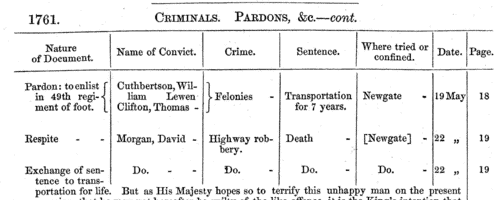Add this eBook to your basket to receive access to all 184 records. Our indexes include entries for the spelling urry. In the period you have requested, we have the following 184 records (displaying 61 to 70): These sample scans are from the original record. You will get scans of the full pages or articles where the surname you searched for has been found. Your web browser may prevent the sample windows from opening; in this case please change your browser settings to allow pop-up windows from this site.  Apprentices registered at Southampton in Hampshire
(1741-1745) Apprentices registered at Southampton in Hampshire
(1741-1745)
Apprenticeship indentures and clerks' articles were subject to a 6d or 12d per pound stamp duty: the registers of the payments usually give the master's trade, address, and occupation, and the apprentice's father's name and address, as well as details of the date and length of the apprenticeship. There are central registers for collections of the stamp duty in London, as well as returns from collectors in the provinces. These collectors generally received duty just from their own county, but sometimes from further afield. (The sample entry shown on this scan is taken from a Norfolk return) | Sample scan, click to enlarge

|  Masters of Apprentices registered at Lincoln
(1741-1745) Masters of Apprentices registered at Lincoln
(1741-1745)
Apprenticeship indentures and clerks' articles were subject to a 6d or 12d per pound stamp duty: the registers of the payments usually give the master's trade, address, and occupation, and the apprentice's father's name and address, as well as details of the date and length of the apprenticeship. There are central registers for collections of the stamp duty in London, as well as returns from collectors in the provinces. These collectors generally received duty just from their own county, but sometimes from further afield. (The sample entry shown on this scan is taken from a Norfolk return) | Sample scan, click to enlarge

| Russell family correspondence
(1670-1754)
Mrs S. C. Lomas of the Historical Manuscripts Commission prepared this report on the manuscripts of Mrs Frankland-Russell-Astley of Chequers Court in Buckinghamshire, published in 1900. There are a few items included earlier than 1670, and a few later than 1754, but broadly the collection was divided into three groups: 1. Russell and Frankland correspondence 1657 to 1697; 2. Cutts and Revett papers 1687 to 1708; 3. Colonel Charles Russell's letters 1742 to 1754. Sir John Russell was married to Frances, daughter of Oliver Cromwell; their daughter Elizabeth married sir Thomas Frankland. Their son John Russell, governor of Fort William in Bengal, married as his second wife Joanna (niece of Lord Cutts) widow of colonel Edmund Revett; and John's son, colonel Charles Russell married Colonel Revett's daughter, Mary Joanna. The largest part of this collection is the correspondence of Colonel Russell, of the 1st Regiment of Foot, and later of the Coldstream Guards, soldiering in the Netherlands. | Sample scan, click to enlarge

| Convicted Criminals
(1763)
When Joseph Redington, Assistant Keeper of the Public Records, calendared the Home Office papers from the accession of king George III, 25 October 1760, to the end of 1765, he gathered together references to criminals from the State Papers Domestic, Warrant Books, and Criminal Papers, and these were printed in tabular form. The information is set out in four sections: -
1. Letters to Judges: giving name of the judge; name of the convict; crime; sentence; where tried or confined; date; page.
2. Petitions in Favour: stating from whom; name of convict; crime; sentence; where tried or confined; object of petition (such as pardon or commutation); date.
3. Reports or Certificates of the Judges, chiefly addressed to the king, on the Cases of Criminals: with name of judge; name of criminal; crime; sentence; where tried or confined; condition of pardon.
4. Warrants and Letters relating to Criminals convicted, being Pardons, Respites &c.: with nature of document; name of convict; crime; sentence; where tried or confined; date; page.
The names of the criminals were not included in the printed index to the calendars, but we have now indexed them year by year. | Sample scan, click to enlarge

|  Apprentices and articled clerks
(1764) Apprentices and articled clerks
(1764)
Apprenticeship indentures and clerks' articles were subject to a 6d or 12d per pound stamp duty (late payment of the 6d rate attracted double duty (D D) of 12d): the registers of the payments usually give the master's trade, address, and occupation, and the apprentice's name, as well as details of the date and length of the apprenticeship. 2 January to 31 December 1764. | Sample scan, click to enlarge

|  Masters of clerks and apprentices
(1765) Masters of clerks and apprentices
(1765)
Apprenticeship indentures and clerks' articles were subject to a 6d or 12d per pound stamp duty (late payment of the 6d rate attracted double duty (D D) of 12d): the registers of the payments usually give the master's trade, address, and occupation, and the apprentice's name, as well as details of the date and length of the apprenticeship. 2 January to 31 December 1765. | Sample scan, click to enlarge

| Spirited and Independent Freeholders of Middlesex
(1769)
This 'LIST of the spirited and independent FREEHOLDERS of MIDDLESEX; Enemies to ministerial Influence, and Court Despotism', giving names and addresses, was published in volume 4 of The Political Register and Impartial Review of New Books, for 1769. | Sample scan, click to enlarge

| Deaths, Marriages, News and Promotions
(1771)
Death notices and obituaries, marriage and birth notices, civil and military promotions, clerical preferments, and bankrupts, as reported in the Gentleman's Magazine. Mostly from England and Wales, but items from Ireland, Scotland and abroad.
| Sample scan, click to enlarge

|  Masters of Apprentices
(1772) Masters of Apprentices
(1772)
Apprenticeship indentures and clerks' articles were subject to a 6d or 12d per pound stamp duty (late payment of the 6d rate attracted double duty (D D) of 12d): the registers of the payments usually give the master's trade, address, and occupation, and the apprentice's name, as well as details of the date and length of the apprenticeship. 2 January to 31 December 1772 | Sample scan, click to enlarge

|  Masters of Apprentices
(1773) Masters of Apprentices
(1773)
Apprenticeship indentures and clerks' articles were subject to a 6d or 12d per pound stamp duty (late payment of the 6d rate attracted double duty (D D) of 12d): the registers of the payments usually give the master's trade, address, and occupation, and the apprentice's name, as well as details of the date and length of the apprenticeship. 2 January to 2 November 1773 | Sample scan, click to enlarge

|
Research your ancestry, family history, genealogy and one-name study by direct access to original records and archives indexed by surname.
|












